Description of the Siberian Giant garlic variety, features of cultivation and care
The dream of every summer resident is to collect a rich harvest from a small plot with a minimum of planting maintenance. That is why most gardeners prefer winter varieties of garlic, which are favorably distinguished by early maturity and high yields. The varietal variety of garlic is great, but the Siberian giant garlic is especially popular among Siberians.
Features of the variety
Type growing varieties of garlic are divided into two varieties: spring and winter. Spring is planted in spring, and winter - before winter.
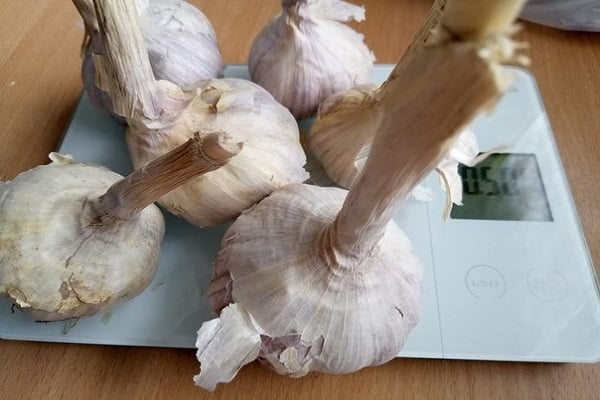
The Siberian giant is a winter variety, shooting, mid-season. It takes 90 to 115 days from germination in spring to full maturity.
Plant characteristic:
- garlic has 5 to 7 green leaves with a slight waxy bloom;
- grows in height up to 70 cm;
- flat-round heads;
- dry husk becomes white with purple veins;
- the bulbs are large with a powerful arrow, the weight of each garlic can reach 100 grams;
- the head has 6 to 9 teeth in a mauve sheath;
- according to the content of essential oils, the Siberian giant belongs to table varieties, it has a spicy-sweet taste and rich aroma;
- it is frost-resistant and well stored.
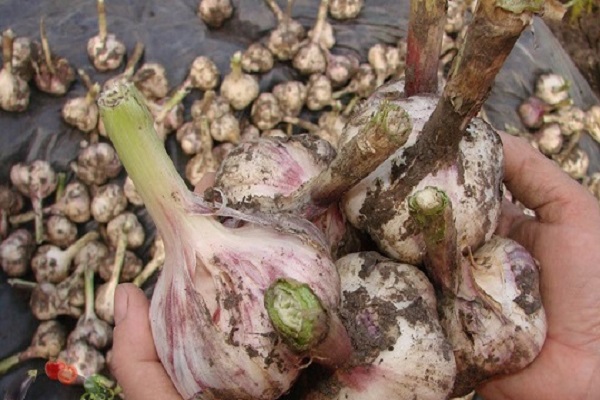
Due to its excellent taste and mouth-watering aroma, the Siberian Giant garlic is excellent for universal use in cooking.
Growing and care
When choosing a variety, one should take into account the description of the plant, the planting time and the peculiarities of the climatic conditions of the region. As a rule, the names speak for themselves. For example, the Siberian giant is intended for cultivation in Siberia, or rather, in the Omsk, Tomsk and Novosibirsk regions.
Winter garlic varieties are planted in the fall, from the end of September until the first frost. With the arrival of spring, the growing season begins and the active growth of the plant begins, and already in mid-July you can harvest.
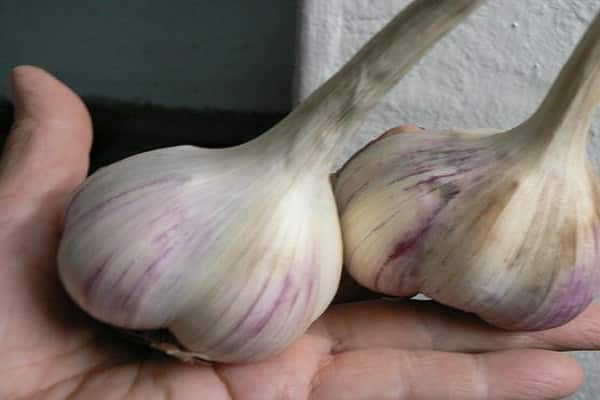
Training
To get a rich harvest, before planting, it is necessary to select seed and prepare the beds:
- On the day of planting, the heads must be divided into teeth, carefully examining each one to ensure the quality of the planting material.
- For preventive purposes, the teeth on the day of planting should be soaked in a solution of potassium permanganate or copper sulfate.
- It is advisable to choose a place for the garden on the sunny side.
Cereals, as well as squash, squash, and cucumbers are ideal precursors for garlic.
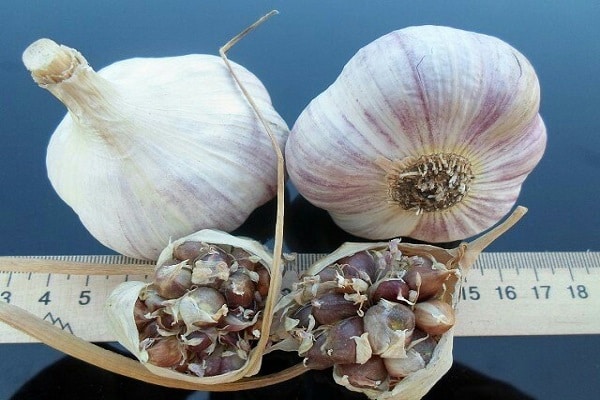
Garlic after garlic can be planted not earlier than after 4 years.
Since the root system of garlic is fibrous and does not go deep into the ground, but is located in the upper layer of the soil, it needs a soil rich in nutrients for full growth.
Fertilizers, which must be applied in late August or early September, will help to increase the fertility of the soil. If the soil is acidic, you need to add ash to it. After fertilizing, the future bed should be treated with a solution of copper sulfate (40 grams per 10 liters) or spilled with a pink solution of potassium permanganate.
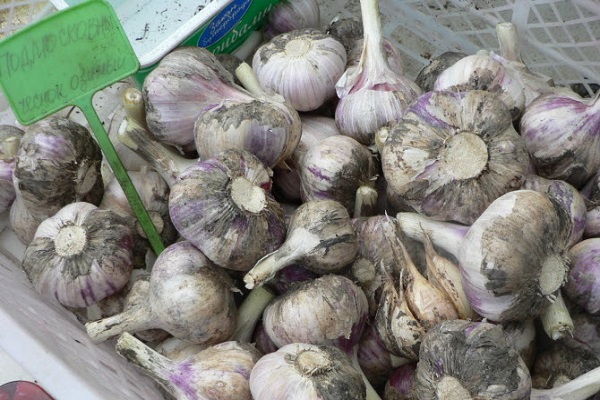
Planting garlic
Winter garlic can be planted as soon as the cold weather sets in, but there is still no frost in the soil. Scheme:
- A two-line landing pattern is preferred. The gap between the seeds should be 10-12 cm, between the "lines" - 10-15 cm, and between the rows - 35-40 cm. The depth of the grooves should be 6-8 cm. With a strong deepening, the garlic will grow smaller, and if it is insufficient, the seeds may freeze.
- The cloves should be placed in the wells in an upright position, bottom down. It is strongly not recommended to press them into the ground, otherwise they can be damaged.
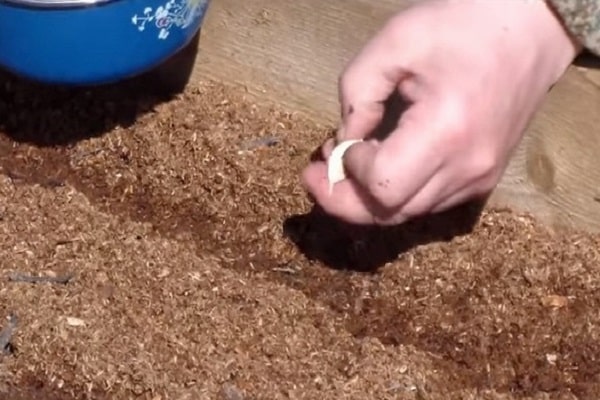
After planting, the grooves need to be sprinkled with earth and the bed should be leveled with a rake, but not tamped. You can also use compost for these purposes instead of soil.
Care advice
The seeds have been sown, the bed is ready, now you need to protect the seedlings from frost in winter. To do this, the soil from above is mulched with grass without seeds and inflorescences or with dry leaves, you can cover the bed with non-woven material. Care:

- After the snow melts, when the first shoots appear, the first top dressing with urea should be carried out (1 tbsp. L. Per 1 sq. M.) And carefully loosen the soil between the rows.
- In the summer, caring for garlic consists of periodic loosening and weeding.
- The plant does not need frequent watering; during its growth it is enough to water it only 2-3 times, but always with warm water.
- Re-feeding should be done when the plant forms 2–4 leaves, and only with mineral mixtures. Manure negatively affects the quality of the future harvest: garlic tops grow abundantly, the bulbs become loose, the risk of infection with fungal diseases increases, and the shelf life decreases.
Experienced gardeners advise not to cut off all the arrows, but to leave a couple of them on the largest plants. In the future, they will help determine the harvest time. When the shells on the arrows burst, you should dig out a couple of heads and make sure that the garlic is ripe.

The most common diseases and pests
Garlic, like other vegetable crops, is damaged by pests and is subject to various diseases. To grow healthy bulbs, you need to find the problem early and get rid of it.
Rust
Fungal disease, one of the most dangerous for garlic. The disease manifests itself on the leaves. In the form of small, slightly convex, rusty spots. With further development, the spots cover the entire plant and turn black, and the leaves wither and dry out.

To prevent the appearance of rust, prophylaxis of seed material is carried out before planting. To do this, the prongs are placed in an oven heated to + 35–40 degrees, and left there for 10–12 hours.
If the spots do appear, the leaves with signs of the disease must be removed immediately, and the plants should be sprayed with specialized products. 1% Bordeaux liquid helps well, as well as solutions of copper sulfate and tar soap.

Stem nematode
One of the most insidious pests that can ruin the entire crop. A nematoda is a white microscopic worm, the size of which does not exceed 1.5 mm. They lay their eggs in the bottoms of the garlic. Nematodes overwinter in bulbs or in soil, preferring heavy, clayey ones. In dry heads of garlic, the pest can persist for more than 4 years.Stem nematodes feed on plant sap, penetrating into them through the bottoms of the bulbs.
When damaged, the garlic begins to lag behind in development, the stem becomes thicker, and the leaves turn yellow. Plants infested later do not differ much from healthy ones, but upon close examination, white spots can be found on the heads. If the infested bulb ends up in storage, the nematodes will spread and may cause dry rot.
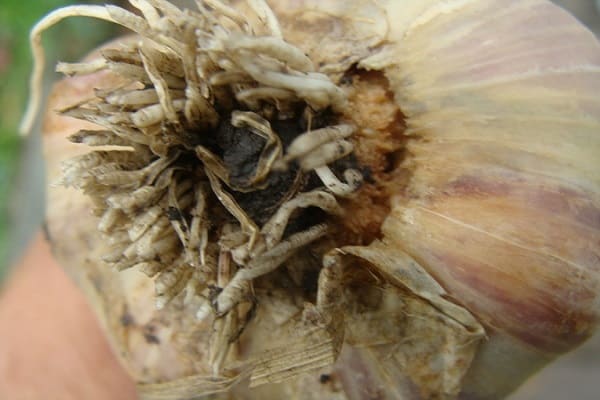
On clay soils, adding peat and sand when digging a site will help prevent the appearance of a stem nematode. As a prophylactic agent, before planting the garlic, spill the garden bed with saline (1 tablespoon salt per 3 liters of water).
The Siberian giant is unpretentious in care; even inexperienced gardeners can grow it. At the same time, it shows excellent results, even despite the difficult weather conditions of Siberia, and the size of the heads proves the correct choice of the name. The Siberian giant is truly a giant garlic.

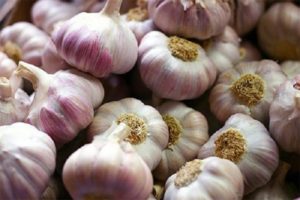
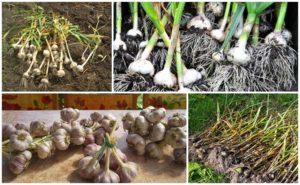

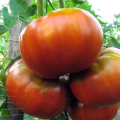

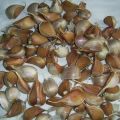


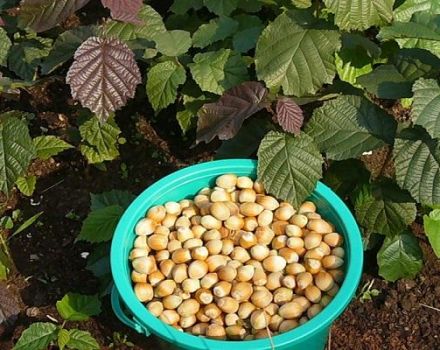

Thank you for the article. Only now I could not determine whether I have such garlic or not. The only thing that starts to sprout in me is only in June, I plant it in late September, early October. The largest of 4 cloves, no longer grows on it. All 4 are well stored. The varieties that I have and which I don’t know. I collected everything from friends and relatives 30 years ago, before it was not very much with the sale of varieties.
My own garlic is very large, but I planted the giant giant in the fall. differs in that Zubkov is much larger. See the difference your grade is 20 years old, it's time to meet others